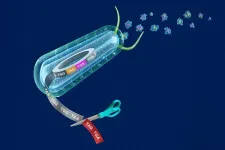(Press-News.org) (Santa Barbara, Calif.) — It’s 1999, the 21st century is on the horizon, and California has big plans for marine conservation. New legislation has presented a mandate to establish an ambitious network of marine protected areas (MPAs) unlike anywhere else in the world. The goal is to craft strategic protections to safeguard the state’s marine life for preservation and economic benefits alike.
Now 25 years later, an international team of researchers, led by scientists at UC Santa Barbara, have evaluated the network’s effects across different species and habitats. “What everyone wants to know is do MPAs work?” said Joshua Smith, lead author of a new study on the matter published in Conservation Biology.
The study confirmed many benefits an MPA can confer to sea life, especially those targeted by fisheries. The authors found that older MPAs, and those with a greater diversity of habitats, showed the highest amount of fish biomass, especially in targeted species, like rockfishes. Stronger protections also correlated with more pronounced results. With international targets aiming to protect more of the world’s oceans, the findings can inform approaches to MPA design and networks that span multiple ecosystems.
An ambitious proposal
Marine protected areas have emerged as a leading tool for protecting ocean ecosystems. But there’s a lot of diversity in the character, size and regulations of MPAs around the world, from a total ban on all extractive or destructive activities to various regulations on infrastructure, water quality, shipping, recreation and so forth.
In 1999, the California Legislature passed the Marine Life Protection Act (MLPA), which required the state to overhaul its marine reserves. The legislation prompted the creation of the first statewide MPA network in the United States, and perhaps the most extensive in the world. “This huge, state-wide network, and its comprehensive design process, was sort of revolutionary at the time,” said co-author Cori Lopazanski, a doctoral student at UCSB’s Bren School of Environmental Science & Management.
“The state invested a ton of time and energy into designing this network of 124 marine protected areas [using the best science of the time],” said Smith, a former postdoc at UCSB and now an ocean conservation research scientist at the Monterey Bay Aquarium. Rather than close a giant area of the ocean, the state decided to set aside a constellation of smaller protected areas distributed across the coast. They specifically engineered the network to enable the interchange of animals, plankton and nutrients between different reserves.
“And now, only years later, are we finally able to evaluate the network in its totality,” said senior author Jennifer Caselle, a research biologist at UCSB.
Synthesizing disparate data
In 2021, scientists converged in Santa Barbara for a working group to inform management recommendations and decisions. The effort was hosted by the National Center for Ecological Analysis and Synthesis (NCEAS), a National Science Foundation research center at UC Santa Barbara.
Twenty-four scientists collaborated on the resulting paper, which sought to determine the conservation performance of 59 MPAs in California’s MPA network. To this end, the authors considered the number of species present in an area, the relative abundance of different species and the overall biomass. Biomass is simply a scientific way to say “pounds of living stuff.” In this case, the researchers looked at pounds of fish.
The researchers compiled long-term data on 170 taxa from the MPA monitoring efforts of four groups, each focused on a different habitat: the surf zone, kelp forest, shallow reef and deep reef. The four monitoring groups had very similar data, but they collected and notated in different ways. So authors had to clean and synthesize the disparate data sources.
Fortunately, the team found a workaround. “For each sampling method, we compared what’s inside the MPA to what’s outside,” Lopazanski said. “Once you have that difference, then you’re just dealing with ratios.”
“Now we could take all of that information and put it in a single analysis that tells us something about how the MPA is performing across all of those ecosystems,” Smith added.
Gains made across the board
Overall, the authors found that MPAs increased fish biomass across the whole network. This primarily came from species targeted by fisheries, which suggests that the protection from fishing really does help boost their population health. Biomass can change in two ways: more fish and larger fish. Although their analysis didn’t distinguish between the two, the authors suspect the gains were a combination of both.
A few characteristics seemed to correlate strongly with conservation benefits. MPAs with more stringent protections saw greater gains, as did areas that had previously experienced heavy fishing. Older MPAs also produced more significant results. “Many fish in California are slow growing and take a long time to mature,” Smith said. “So it makes sense that the benefits of MPAs are going to take time to actually manifest.”
Habitat diversity emerged as a major predictor of success, as well. Although scientists and fishermen often classify species by their preferred habitat, a single fish may move between habitats from day to day. “If you have different habitats in proximity to each other, then there’s more variability in the types of resources, foods, shelters — the types of things fish need to survive — in the space where they’re living” Lopazanski said. Including diverse habitats within an MPA ensures that fish don’t have to leave an MPA to seek these things out.
Interestingly, none of these features appeared to influence the number or relative abundance of different species present. Smith suspects the former may stem from California’s past stewardship. The state has boasted strong fishery management for decades, so few species were completely gone from any area, he explained. As for the other marker of diversity, protection can increase the number and size of fishes without necessarily changing the relative abundance of different species.
New analysis validates past decisions
The authors are encouraged by their findings. “It was exciting to see that all of the planning and design that went into putting this huge network into place was producing many of its intended benefits,” Lopazanski remarked.
One of the strengths of a marine reserve is that it can protect large areas with many species. “MPAs are always designed to protect multiple habitats, but they are rarely evaluated with all of the different habitats in a single study,” Caselle said. And that’s in part because scientists specialize. But California supports broad monitoring efforts across its marine reserves, and this paper analyzes all these habitats at once.
END
California’s marine protected areas boost fish populations across the state
A system-wide evaluation of California’s marine reserve network finds conservation benefits across multiple ecosystems
2025-02-11
ELSE PRESS RELEASES FROM THIS DATE:
Poachers’ social media posts reveal alarming extent of illegal wildlife hunting in Lebanon
2025-02-11
Public posts on social media platforms shed light on the extent and nature of prolific illegal wildlife hunting in Lebanon, research in Oryx—The International Journal of Conservation, published by Cambridge University Press on behalf of Fauna & Flora, has found.
The study is the first to use social media as a tool for assessing illegal hunting activities in Lebanon. The country, along with the Mediterranean region more broadly, is a global poaching blackspot, particularly for the illegal killing of protected ...
Examining the potential environmental effects of mining the world’s largest lithium deposit
2025-02-11
DURHAM, N.C. -- The world’s largest known lithium deposit exists within a vast salt pan called the Salar de Uyuni, which stretches for thousands of square miles atop a high, dry Andean plateau in Bolivia. For most of the year, salt crystals encrust the terrain, white as confectioner’s sugar. During the wet season, pooling rainwater mirrors surrounding mountains and sky.
“The Salar is a magical place for travelers from all over the world who come to see the colors, the reflections, in this endless white landscape,” said Avner Vengosh, Nicholas Chair of Environmental Quality at the Duke University ...
Chicken ‘woody breast’ detection improved with advanced machine learning model
2025-02-11
FAYETTEVILLE, Ark. — It’s called “woody breast” and for consumers it can mean a chewier chicken sandwich, but for the industry it can mean up to $200 million annual yield loss.
Work done by the Arkansas Agricultural Experiment Station is not only making woody breast easier to detect in chicken meat but is accurate up to 95 percent of the time.
The development could help improve quality assurance and customer confidence in one of the state’s most economically important agricultural products. What allows ...
Around 1 in 5 UK medical students considers dropping out, study suggests
2025-02-11
Around 1 in 5 UK medical students considers dropping out of medical school, with mental health issues a key contributor to their intention to abandon medicine, suggest the results of an observational study published in the open access journal BMJ Open.
The shortage of doctors worldwide is a major cause for concern, say the researchers, with the current shortfall thought to be around 6.5 million.
These shortages not only affect the quality of patient care, but also doctors’ wellbeing as a result of increased workload and chronic stress, which further undermine recruitment and retention, creating a vicious circle, they add.
Given that medical ...
Poor childhood social and cognitive skills combo linked to teens’ poor exam results
2025-02-11
The combination of poorly developed social and cognitive skills during childhood is linked to poor exam results by the age of 16, with those for whom these issues persist throughout their childhood more than 4 times as likely not to pass at least 5 GCSEs, finds research published online in the Archives of Disease in Childhood.
The findings, which are based on a large set of nationally representative data, suggest that childhood cognitive and behavioural issues may be behind 17% of GCSE (General Certificate of Secondary Education) exam fails among 16 year olds, conclude the researchers.
“Years in school matter, not just for exam results, but for skills and capacity development. ...
Position menstrual cups carefully to avoid possible kidney problems, doctors urge
2025-02-11
A poorly positioned menstrual cup to capture monthly blood flow may lead to more serious complications than leakage alone, warn doctors in the journal BMJ Case Reports, after treating a young woman with uterohydronephrosis—a swollen kidney caused by blocked urine flow into the bladder.
The use of menstrual cups as a sustainable alternative to other methods of controlling period blood flow is rising, note the report authors. While reported complications are rare, the evidence suggests that pain, vaginal wounds, allergic reactions, ...
Yale scientists recode the genome for programmable synthetic proteins
2025-02-10
New Haven, Conn. — Synthetic biologists from Yale were able to re-write the genetic code of an organism — a novel genomically recoded organism (GRO) with one stop codon — using a cellular platform that they developed enabling the production of new classes of synthetic proteins. These synthetic proteins, researchers say, offer the promise of innumerable medical and industrial applications that can benefit society and human health.
The creation of the landmark GRO, known as “Ochre” — which fully compresses redundant, or “degenerate” codons, into a single codon — is ...
MiR-128-3p mediates MRP2 internalization in estrogen-induced cholestasis through targeting PDZK1
2025-02-10
https://www.scienceopen.com/hosted-document?doi=10.15212/AMM-2024-0053
Announcing a new publication for Acta Materia Medica journal. Estrogens have been reported to cause dysfunction in biliary transport systems, thereby inducing cholestasis. Multidrug resistance-associated protein 2 (MRP2) is a transporter responsible for independent bile flow. Emerging evidence indicates that PDZ domain containing 1 (PDZK1) regulates localization of MRP2; however, PDZK1’s role and regulatory machinery in MRP2-mediated estrogen-induced cholestasis (EIC) remain unclear.
The authors of this article observed, in a mouse model of EIC, downregulated PDZK1 expression in the liver and enhanced intracellular ...
Bleeding risk with apixaban and dabigatran similar to aspirin
2025-02-10
Embargoed for release until 5:00 p.m. ET on Monday 10 February 2025
@Annalsofim
Below please find summaries of new articles that will be published in the next issue of Annals of Internal Medicine. The summaries are not intended to substitute for the full articles as a source of information. This information is under strict embargo and by taking it into possession, media representatives are committing to the terms of the embargo not only on their own behalf, but also on behalf of the organization they represent.
----------------------------
1. ...
MD Anderson Research Highlights for February 10, 2025
2025-02-10
HOUSTON ― The University of Texas MD Anderson Cancer Center’s Research Highlights showcases the latest breakthroughs in cancer care, research and prevention. These advances are made possible through seamless collaboration between MD Anderson’s world-leading clinicians and scientists, bringing discoveries from the lab to the clinic and back. This issue includes studies to be presented this week at the 2025 American Society of Clinical Oncology (ASCO) Genitourinary Cancers Symposium.
Metastasis-directed therapy shows favorable ...
LAST 30 PRESS RELEASES:
Making lighter work of calculating fluid and heat flow
Normalizing blood sugar can halve heart attack risk
Lowering blood sugar cuts heart attack risk in people with prediabetes
Study links genetic variants to risk of blinding eye disease in premature infants
Non-opioid ‘pain sponge’ therapy halts cartilage degeneration and relieves chronic pain
AI can pick up cultural values by mimicking how kids learn
China’s ecological redlines offer fast track to 30 x 30 global conservation goal
Invisible indoor threats: emerging household contaminants and their growing risks to human health
Adding antibody treatment to chemo boosts outcomes for children with rare cancer
Germline pathogenic variants among women without a history of breast cancer
Tanning beds triple melanoma risk, potentially causing broad DNA damage
Unique bond identified as key to viral infection speed
Indoor tanning makes youthful skin much older on a genetic level
Mouse model sheds new light on the causes and potential solutions to human GI problems linked to muscular dystrophy
The Journal of Nuclear Medicine ahead-of-print tip sheet: December 12, 2025
Smarter tools for peering into the microscopic world
Applications open for funding to conduct research in the Kinsey Institute archives
Global measure underestimates the severity of food insecurity
Child survivors of critical illness are missing out on timely follow up care
Risk-based vs annual breast cancer screening / the WISDOM randomized clinical trial
University of Toronto launches Electric Vehicle Innovation Ontario to accelerate advanced EV technologies and build Canada’s innovation advantage
Early relapse predicts poor outcomes in aggressive blood cancer
American College of Lifestyle Medicine applauds two CMS models aligned with lifestyle medicine practice and reimbursement
Clinical trial finds cannabis use not a barrier to quitting nicotine vaping
Supplemental nutrition assistance program policies and food insecurity
Switching immune cells to “night mode” could limit damage after a heart attack, study suggests
URI-based Global RIghts Project report spotlights continued troubling trends in worldwide inhumane treatment
Neutrophils are less aggressive at night, explaining why nighttime heart attacks cause less damage than daytime events
Menopausal hormone therapy may not pose breast cancer risk for women with BRCA mutations
Mobile health tool may improve quality of life for adolescent and young adult breast cancer survivors
[Press-News.org] California’s marine protected areas boost fish populations across the stateA system-wide evaluation of California’s marine reserve network finds conservation benefits across multiple ecosystems



